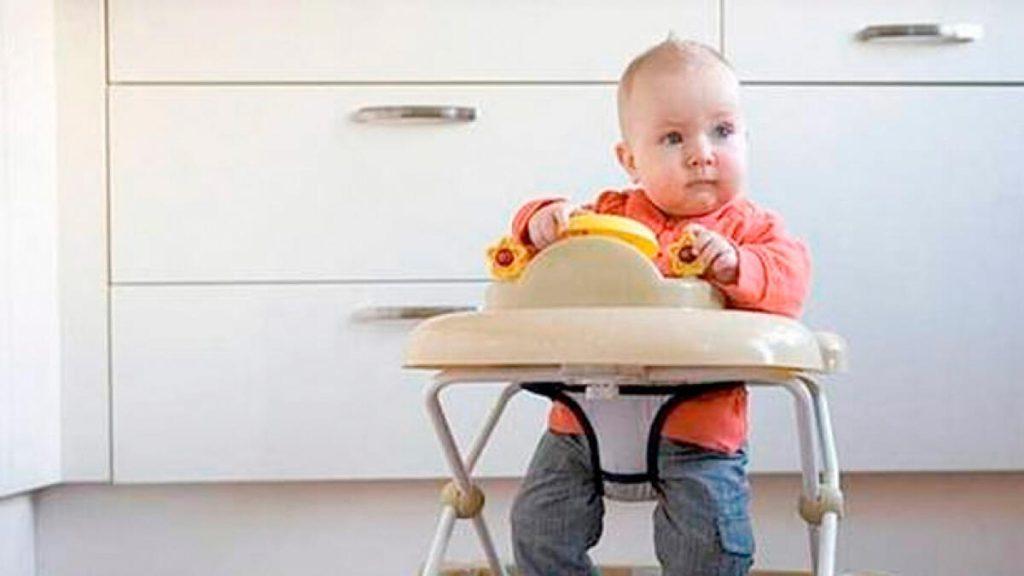
Here are some pros and cons of baby walkers:

Entertainment:
Baby walkers often come with trays or attached toys, which keep infants entertained and occupied. Many baby walkers come equipped with toys, buttons, and other interactive features. Engaging with these elements can stimulate a child’s sensory and cognitive development.
Pros of Baby Walkers:
Improved motor skills:
- Pro: Baby walkers stimulate the development of motor skills. Children use their legs to move.
- Pro: Repetitive movement helps to strengthen the muscles of the legs and improve coordination.
Cognitive stimulation:
- Pro: Many modern walkers come equipped with interactive features, toys, and buttons, which provide cognitive stimulation to the child.
Engaging with these qualities promotes early learning and problem-solving skills.
Fun and activities:
- Pros: Walkers often serve as a source of entertainment for children. They are connected to the surrounding environment.
- Pros: Connected toys and colourful elements contribute to an enjoyable and playful experience.
Initial freedom:
- Pro: As children learn to walk with a walker, they feel a sense of freedom in exploring their surroundings.
- Pros: This early freedom can boost confidence and contribute to emotional development.
For the benefit of parents:
The use of a baby walker can provide a temporary solution for parents. This allows them to engage in other activities while keeping the child entertained and active.
Cons of Baby Walkers:

The security concerns:
Safety is a primary concern. Pedestrians may have access to potentially dangerous areas or objects.
Delayed development milestones:
- Con: Some people say that the prolonged use of walkers can delay some developmental milestones, like crawling and walking without any help.
- Con: Dependence on the walker for movement can hinder the natural development of motor skills.
Restricted use at unequal levels:
- Con: Walkers are most effective on flat, even surfaces. And may not perform well on uneven terrain.
- Con: This limit may limit the child’s exploration in an outdoor or low-control environment.
Misuse and misuse of currency:
- Misuse, such as extended periods or incorrect height settings, can lead to poor posture in children.
- Con: Parents need to follow the instructions for the safe and proper use of the walker.

Controversial safety record:
- Con: Baby walkers have faced controversy and safety concerns. This has led to regulatory changes in some areas.
- Research and safety features must be followed when selecting and using a walker.
Finally, while baby walkers offer developmental benefits, parents need to understand the advantages and disadvantages carefully. Strict adherence to safety guidelines and regular monitoring are paramount to ensuring a positive and safe experience for the child.
Baby walkers can be both a boon and a challenge for parents navigating the world of infant care. On the positive side, baby walkers can provide entertainment and mobility for little ones, fostering a sense of independence and exploration. They often come equipped with interactive toys, stimulating a baby’s sensory development. Additionally, walkers can offer parents a brief respite as their baby moves around in a controlled environment.

However, the use of baby walkers also comes with its own set of concerns. Safety is a paramount issue, as accidents can occur if the baby gains access to potentially hazardous areas or falls down stairs. Pediatricians often express reservations about walkers hindering the natural development of walking skills, as some argue that they may delay the development of crucial muscles. Moreover, excessive use of walkers might lead to a reliance on the device, potentially affecting the baby’s motivation to learn to walk unaided.
In weighing the pros and cons of baby walkers, parents must consider their child’s individual needs, closely monitor usage, and create a safe environment to ensure a balance between the benefits and potential drawbacks of these popular baby accessories.
Frequently Asked Questions (FAQs)
How Baby Walkers Benefit Children?
Baby walkers provide fun and stimulation through attached toys; it promotes cognitive and emotional development. They also offer the initial freedom to explore the environment. It helps in emotional development.
Do baby walkers improve motor skills?
Yes, the use of a baby walker can improve motor skills by stimulating leg movement and strengthening leg muscles. Repetitive movement helps in the development of harmony.
What are the disadvantages of baby walkers?
Safety concerns include access to dangerous areas and potential accidents. Prolonged use can delay development milestones such as crawling and walking independently. Additionally, appropriate settings can lead to good posture in children.
Baby walkers are effective on all levels?
Baby walkers are the most effective on flat, even surfaces, which limits the search in outdoor or rugged terrain environments.
How should parents approach the use of a baby walker?
Parents should carefully review the benefits and harms of baby walkers, strictly follow safety guidelines, closely monitor use, and create a safe environment to ensure a positive and safe experience for their child.
Conclusion
Baby walkers offer both benefits and challenges for parents and children. While they provide fun, movement, and stimulation for children, Safety concerns and potential development delays should be carefully considered. Parents should prioritize safety, closely monitor use, and create an environment conducive to balancing the benefits and harms of baby walkers for their child’s well-being.
